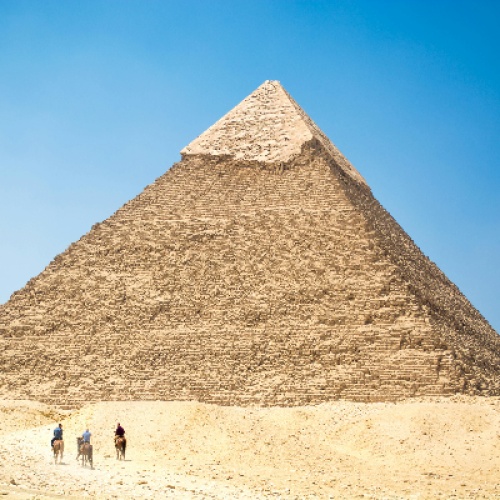1. Historical Context
Dynastic Egypt: The pyramids were constructed during Egypt's Old Kingdom, especially during the 3rd to 6th Dynasties (around 2686 - 2181 BCE). The Great Pyramid of Giza, built for Pharaoh Khufu (Cheops), is the most famous and is often referred to as one of the Seven Wonders of the Ancient World.
2. Construction Techniques:
Materials: The core of the pyramids was built with locally quarried limestone, while higher-quality limestone for the outer casing was often imported. Granite blocks, used in some internal chambers, were transported from quarries in Aswan.
Labor: Contrary to the myth of slave labor, evidence suggests that the pyramids were built by a large workforce of skilled laborers and artisans who were well-fed and housed in nearby workers' villages. These workers were likely conscripted from various parts of Egypt and worked in rotating shifts.
Techniques: The construction involved advanced knowledge of mathematics and engineering. Ramps (straight, zigzagging, or circular) and levers were used to move and place the massive stones. Recent discoveries suggest that the construction process was highly organized and carefully planned.
3. Mathematical Precision:
Alignment: The pyramids are aligned with incredible precision to the cardinal points (north, south, east, west). This alignment may have had religious or astronomical significance, possibly reflecting the ancient Egyptians' sophisticated understanding of the stars and celestial events.
Proportions: The Great Pyramid's proportions are based on precise geometric ratios, which some theorists believe might have had symbolic meanings related to sacred geometry.
4. Astronomical and Religious Significance:
Astronomy: The pyramids' alignment and dimensions may have been designed to reflect certain astronomical phenomena or to align with specific stars, such as Sirius or Orion's Belt.
Religion: Pyramids were built as tombs for pharaohs and high-ranking officials, reflecting the belief in an afterlife. The shape of the pyramid is thought to symbolize the rays of the sun and the ascent of the soul to the heavens.
5. Archaeological Discoveries:
Workers' Village: Excavations at Giza have revealed evidence of a large workers' village, providing insights into the lives of those who built the pyramids.
Tools and Techniques: Archaeologists have found tools, such as copper chisels and wooden sledges, which were used in the quarrying and transport of stone blocks.
6. Alien Theories:
Origins of the Idea: The concept of aliens being involved in pyramid construction gained popularity in the 20th century through books and TV shows, often as a way to explain the advanced technology and knowledge required to build such massive structures.
Lack of Evidence: There is no credible evidence to support the idea that extraterrestrials were involved in the construction of the pyramids. The techniques used were well within the capabilities of ancient Egyptian society, as evidenced by extensive archaeological research.
7. Modern Research and Exploration:
Technological Advances: Modern technologies, such as ground-penetrating radar and 3D modeling, continue to reveal more about the pyramids' construction methods and internal structures.
Ongoing Mysteries: While much has been learned, some aspects of pyramid construction and the daily life of the workers remain subjects of active research and debate.
The pyramids remain a testament to ancient Egyptian ingenuity and their sophisticated understanding of engineering and astronomy.
Dynastic Egypt: The pyramids were constructed during Egypt's Old Kingdom, especially during the 3rd to 6th Dynasties (around 2686 - 2181 BCE). The Great Pyramid of Giza, built for Pharaoh Khufu (Cheops), is the most famous and is often referred to as one of the Seven Wonders of the Ancient World.
2. Construction Techniques:
Materials: The core of the pyramids was built with locally quarried limestone, while higher-quality limestone for the outer casing was often imported. Granite blocks, used in some internal chambers, were transported from quarries in Aswan.
Labor: Contrary to the myth of slave labor, evidence suggests that the pyramids were built by a large workforce of skilled laborers and artisans who were well-fed and housed in nearby workers' villages. These workers were likely conscripted from various parts of Egypt and worked in rotating shifts.
Techniques: The construction involved advanced knowledge of mathematics and engineering. Ramps (straight, zigzagging, or circular) and levers were used to move and place the massive stones. Recent discoveries suggest that the construction process was highly organized and carefully planned.
3. Mathematical Precision:
Alignment: The pyramids are aligned with incredible precision to the cardinal points (north, south, east, west). This alignment may have had religious or astronomical significance, possibly reflecting the ancient Egyptians' sophisticated understanding of the stars and celestial events.
Proportions: The Great Pyramid's proportions are based on precise geometric ratios, which some theorists believe might have had symbolic meanings related to sacred geometry.
4. Astronomical and Religious Significance:
Astronomy: The pyramids' alignment and dimensions may have been designed to reflect certain astronomical phenomena or to align with specific stars, such as Sirius or Orion's Belt.
Religion: Pyramids were built as tombs for pharaohs and high-ranking officials, reflecting the belief in an afterlife. The shape of the pyramid is thought to symbolize the rays of the sun and the ascent of the soul to the heavens.
5. Archaeological Discoveries:
Workers' Village: Excavations at Giza have revealed evidence of a large workers' village, providing insights into the lives of those who built the pyramids.
Tools and Techniques: Archaeologists have found tools, such as copper chisels and wooden sledges, which were used in the quarrying and transport of stone blocks.
6. Alien Theories:
Origins of the Idea: The concept of aliens being involved in pyramid construction gained popularity in the 20th century through books and TV shows, often as a way to explain the advanced technology and knowledge required to build such massive structures.
Lack of Evidence: There is no credible evidence to support the idea that extraterrestrials were involved in the construction of the pyramids. The techniques used were well within the capabilities of ancient Egyptian society, as evidenced by extensive archaeological research.
7. Modern Research and Exploration:
Technological Advances: Modern technologies, such as ground-penetrating radar and 3D modeling, continue to reveal more about the pyramids' construction methods and internal structures.
Ongoing Mysteries: While much has been learned, some aspects of pyramid construction and the daily life of the workers remain subjects of active research and debate.
The pyramids remain a testament to ancient Egyptian ingenuity and their sophisticated understanding of engineering and astronomy.




